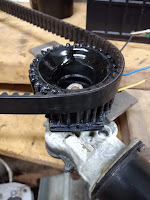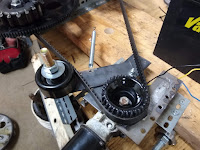May 9, 2020, Prepping for Road Testing
Preparations are under way to be ready and able to perform the next phase of operations, which is road testing. Since this will be tested in an open-air pick-up truck bed, several issues come to mind.
First, unattended operation. Nobody will be in the back with it due to state laws prohibiting riding in the back of a truck. If timing does slip, or there is a mechanical failure there will be a significant time lag between the failure point and human intervention. (Note: Most testing facilities also prohibit open-air riders without expensive safety harnesses and specialized equipment)
Second, the weather. The PIE needs to have some protection from inclement weather and from any debris that the wind could potentially deposit in the open gear mechanics of the PIE.
Third, nosy people. This is potentially the trickiest part of the testing. At this early stage of testing, a bit of privacy would be advantageous. The public is invited to view the data, pictures & videos online. Eventually there will be public demonstrations.
Preparations:
Secure vehicle mounting, with a weather resistant cover (hood).
Remote switching control, I prefer hard wiring for reliability.
Video monitoring, it would be good to keep an eye on the PIE if possible.
Graphic monitoring of engine load, done via vehicle computer interface.
PIE timing adjustments made & verified.
Tensioner spring tightened. Additional belt support may be necessary if there is a problem.
Tensioner spring tightened. Additional belt support may be necessary if there is a problem.
Note:
Moving the PIE & all its fixings back and forth numerous times, I can say that it most definitely wasn’t built with weight limitations in mind. That’s a polite way of saying that it’s freakin’ heavy.
I got out my digital AC scale & weighed the PIE, battery & axles just to get an Idea of the heft of the components.
Weight of the current PIE is 46.46 lbs., not including battery or rolling axles.
Weight of pair of axles used is 3.640 lbs., these won’t be needed for road testing.





















